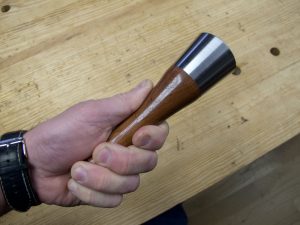We may receive a commission when you use our affiliate links. However, this does not impact our recommendations.
When it comes to holding a woodworking tool in our hands for hours at a time, we have two choices: change the tool or change our attitude.
Most woodworkers – surprisingly – refuse to change the tools. Perhaps we’re afraid we’ll make it worse. Or we don’t know what to alter on the tool. Or we don’t want to reduce the value of a tool that is valuable to collectors.
So we adapt our muscles and our minds.
This little theory of mine is at the front of my thoughts this week as I’m testing out two new woodworking mallets and comparing them to my Blue Spruce 16 oz. mallet, which I have been using since 2009. It weighs 1 lb. 1 oz. Also on my bench is the new Lee Valley Large Journeyman’s Mallet (1 lb. 2 oz.) and a new carving mallet sold by Mary May and made by David Reilly (1 lb. 4 oz.).
Mallets are funny things. I used a traditional square-head mallet for more than 15 years. Every other mallet I picked up in stores during that time felt weird in my hands. Even other square-head mallets that had different chamfers, different handle lengths or different weights all felt wrong.
I was convinced I had the perfect mallet for me.
But then I started teaching and I left my little cocoon. I started working with other people’s tools and slowly found out I could use almost any mallet except the soft rubber ones from the home centers – those just bounced back at me.
So what makes a good mallet? In my book, I think a mallet that is compact, comfortable and about 1 lb. or so is good for driving most tools. I like mallets that deliver a good knock and don’t rebound like you are working in a bounce house. And I like mallets that are comfortable in two positions: with my hand at the end of the handle for delivering sharp blows, and with my hand around the head for love taps.
With those specs in mind, here are my thoughts on these three mallets.
Lee Valley Journeyman’s Mallet: I promise you that this will be a popular little tool. It is compact, well made, made in Canada and costs less than $30. The cherry handle is crisply turned and nicely finished.
And if you don’t like the handle, unscrew it from the head and turn a new one (I know you won’t do this, however, but I had to mention it).
The 1-1/8” girth of the handle and 1-5/8”-diameter head are just right for my average-sized hands. The biggest plus of this mallet – besides its price – is its compact size. At only 6” long it can fit in almost any cranny of a tool chest.
Mary May & Dave Reilly mallet: This mallet is intended for carvers, but it is an excellent chisel mallet as well. I purchased the steel-headed one, though they also make it in brass. The handle is beautifully turned and flows right into the steel head.
What is interesting about the handle is how different the two hand positions are on the tool. The thin midsection of the handle really encourages this. When you grab the end – for power – the end of the handle is in your palm. This gives the mallet surprising punch.
Likewise, when you wrap your hand around the head it automatically slips right into the perfect position. There is no middle ground. Grasping the handle right in the middle doesn’t feel right at all. This isn’t a criticism. It’s a good thing.
My only criticism of the tool is the tool is signed with a hand engraver and it isn’t up to the excellent level of fit and finish on the rest of the tool.
Blue Spruce 16 oz. Mallet: I love everything about this mallet except the space it takes up in my chest – it’s more than 9-3/4” long. I’ve written about this mallet quite a lot (check it out here on the blog). The maple head is impregnated with a resin, which makes it last and last and last. I have chopped hundreds and hundreds of dovetails with this mallet and it still looks like new – barely a ding.
The handle has its swelling near the bottom, though not as low as on the Mary May Dave Reilly mallet. The Blue Spruce is remarkably comfortable no matter where you grab it.
The only weakness of this mallet is in the joint between the head and handle. If you use this mallet to bludgeon holdfasts or other metal objects, you can crack the handle.
All three of these tools are ideal choices for your everyday mallet. Pick one that suits your pocketbook or catches your fancy. Your hand will shake on it and – in a short time – make friends.
— Christopher Schwarz
Learn more about handwork with my 2-DVD set: “Mastering Hand Tools.” We cover all the basic hand tools (including mallets) and show how to choose and use them. And it’s only $15.
Here are some supplies and tools we find essential in our everyday work around the shop. We may receive a commission from sales referred by our links; however, we have carefully selected these products for their usefulness and quality.















I had ordered the pair (large and small) from LV a day or so before you posted this. Got them and found the large one a bit small in the handle for my big paws. My new handle is built around a 4″ hanger bolt, and about 1.5 inches longer, and a bit bigger at the back. The waited area is about the same. Most comfortable mallet I’ve used.
I find my old ironwood mallet to be just fine. I made it from a piece of tree I cut down for firewood probably 20 years ago – figured if it was hard enough to ruin a saw chain and too hard to split, it would make a good tool. I don’t know if I adjusted to it in use, or if I lucked into a good fit right off, but I haven’t felt a need to tinker with the fit or feel. It is about 8″ long, with a 3″ diameter cylindrical working end (I took off the bark and cambium layer) and 1″ handle, probably a bit over 1 lb. I left the head a bit rough for some friction in use.
One of the simplest tools a woodworker can make for himself. I get a sense of pleasure every time I chisel out a mortise with it.
In the Anarchist Tool Chest you recommend a 10oz metal mallet now it appears something changed and you are going heavier. Any reason for the change? And if you wouldn’t mind please post 45min earlier. I ordred the lighter mallet just ahead of this post.
I have a LV journeyman’s mallet somewhere. I did make a new, longer handle for it. The hanger bolt design resulted in a split handle. I reinforced with a strip of linen and glue, and it was fine after that. The Mary May model won’t have that problem.
I also tried a Calvo brass mallet… Same thru-tenon design as the Mary May, but bigger, I think. Then I added a long handle to that one, too.
Ultimately settled on a Japanese hammer.
In a pinch one day, having left my prized Blue Spruce mallet at home, I was forced to resort to using my $11 big box store dead blow hammer for some chopping of dovetails. I haven’t picked up the Blue Spruce since. All I can say is, try it. The plastic is kind to wooden chisel handles, and the dead blow effect outweighs any aesthetic considerations. Dead blow mallets are available in several different weights, so try a few options.
Mallets are like old Tee Shirts that are full of holes but give you a warm feeling when you look at them. It’s all you can do to give them up but sooner or later you must.
I have a mallet made from a pear limb I salvaged when I first started “fine” woodworking. I messed up the handle, it’s too small and has band saw marks on it but one side has wane showing and is very lovely and gives the mallet a direction to go. I’ll never part with this mallet even though the weight is probably a little shy. I’m making some more from a bodark tree (ok, bois d’arc, but I’m in Oklahoma) I salvaged and will have better handles.
I think I’ll saw off the handle on the old mallet, I still have some of the old tree left, and make a new one, maybe sink a little lead in it too. But it stays.
You know, you’re right. I’ve always gotten used to my old bosses…
/Bazinga
I like theory too. Judging from the photos and your comments, it seems that a slightly narrow waist perhaps 3 or 3-1/2″ from the business end enhances comfortable love taps. Below this narrowocity*, an elongated bulb sized to nestle into the palm is good for fetching a solid whack. Does the abrupt transition from handle to head in the Veritas affect the comfort? It seems that with the Blue Spruce, the entire head rests in the palm, so the even more abrupt transition wouldn’t matter. I’m curious because my traditional lignum vitae mallet is a little big for love taps, so I may investigate alternatives – which might involve ordering something sight-unseen over the Internet. Thanks.
* I really couldn’t write “Below the waist….”